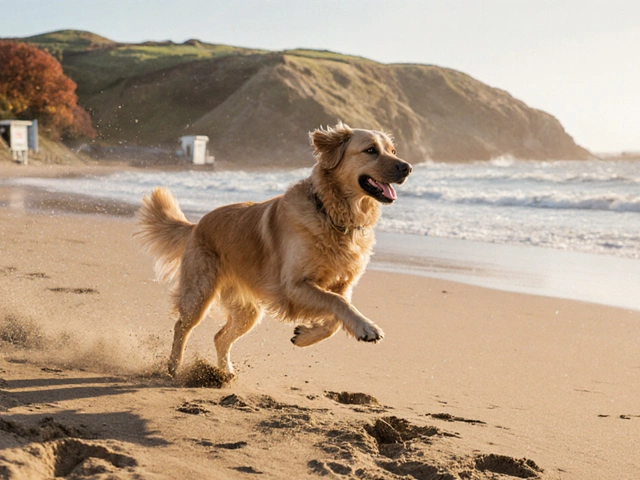Got a big furball ready to hit the road with you? Traveling with a 70-pound dog might sound like a logistical nightmare, but trust me, it’s way more doable than you’d imagine. The key is in the prep work. From deciding on the best travel method to packing the right gear, every step can make life easier for both you and your canine companion.
Before you even think about setting out, think about your dog's needs. Are they the type to get excited at the prospect of a car ride, or do they immediately associate the back seat with vet visits? Understanding their temperament and past travel experiences can save a lot of fuss on the day. It’s not just about having a robust crate or harness – though those are super important – it’s about readiness and patience too.
- Preparing for the Journey
- Packing Essentials for Your Dog
- Choosing the Right Mode of Transport
- Keeping Your Dog Comfortable and Safe
- Handling Challenges on the Road
Preparing for the Journey
When it comes to traveling with a 70-pound dog, preparation is your best friend. Before you embark on any adventure, there are a few things you'll want to check off your list. This is especially crucial if you're traveling long distances or planning on crossing state or international borders.
Health Check
Start with a visit to the vet. Ensure your dog's vaccinations are up to date. Many places require proof of these for entry, especially when flying or crossing borders. Get a health certificate if needed, and make sure your dog's ID tags or microchip information is current.
Training Basics
Does your dog listen to basic commands like sit, stay, or come? These are vital, especially when you're navigating new and potentially chaotic environments. If they’re not quite there yet, a quick refresher might be in order. Plus, if you're using public transport or staying in hotels, having a well-behaved pooch will make things smoother.
Setting Up Your Ride
If you're hitting the road, ensure your vehicle is dog-friendly. Lay down some blankets or a dog mat to keep them comfortable. Use a pet seat belt or a sturdy crate to prevent distractions or accidents.
Scheduling and Planning
Avoid feeding your dog right before travel. It can lead to nausea, much like for us humans. Instead, give them a light meal a few hours before setting off. Plan for breaks; stop every 2-3 hours on road trips to let your dog stretch and relieve themselves.
Documentation
- Vaccination Records: Essential for travel by air or across borders.
- Health Certificates: Especially needed for flying or entering some states/countries.
- ID Tags: Updated with your current contact info.
| Task | When to Do |
|---|---|
| Visit the Vet | 1-2 weeks before travel |
| Training Refresher | 2-4 weeks before travel |
| Check Transport Setup | 1 week before travel |
| Document Prep | 1 week before travel |
Getting all these things sorted will give you peace of mind and help keep things stress-free for both you and your pet. Start early, be thorough, and you’re well on your way to a successful trip with your furry co-pilot!
Packing Essentials for Your Dog
Preparing to travel with your 70-pound dog starts with packing the right stuff. It’s sort of like packing for yourself but with a furry twist. Here’s what you’ll need to make sure you’ve got all bases covered.
Travel Crate or Harness
First things first, consider safety. A sturdy travel crate or a strong harness is essential. Not only do they keep your dog secure, but they also prevent distractions while you drive or fly. Pick a crate that’s big enough for your dog to stand up, turn around, and lie down comfortably, but not so large that they get thrown around during travel.
Food and Water Supplies
Next up is food and water. Depending on the length of your trip, measure out enough of your dog's usual kibble, and pack it in a secure container. You’ll also want a collapsible water bowl for when your pet gets thirsty. Staying hydrated on the road is just as important for dogs as it is for humans.
Bedding and Toys
Comfort is key when it comes to keeping your canine chill during travel. Bring along their favorite bed or blanket to provide a sense of familiarity. Plus, a few toys will keep your pet entertained and less likely to get antsy while on the journey.
Health and Safety Kits
Don't forget health essentials. Have a basic first-aid kit ready, with items like bandages, antiseptic wipes, and any necessary medications. Also, keep your vet's contact info handy just in case.
ID and Paperwork
Always make sure your dog is wearing an ID tag with up-to-date contact info. If you're traveling internationally or by air, bring vaccination records and other necessary documents. It’s all about being prepared for whatever comes your way.
- pet travel: crate or harness, ID tags
- dog transport: food, water, and familiar bedding
- traveling with pets: first-aid kit, vet documentation
By packing these essentials, you’re setting yourself and your pup up for a smooth sailing travel experience. It might sound like a lot, but these items go a long way in making sure your dog remains happy and healthy on the trip.

Choosing the Right Mode of Transport
When it comes to traveling with your 70-pound fur buddy, selecting the right transport method is crucial. Getting it wrong might turn an exciting trip into an exhausting ordeal. Your choice largely depends on your destination, budget, and, of course, your dog's comfort level.
By Car
For short distances or road trips, cars are generally the best option. They give you flexibility with stops and control over your pet's environment. Make sure to secure your dog with a dog harness that attaches to the seatbelt or put them in a sturdy crate to keep them safe and cozy. Frequent breaks are your best friend here—plan pit stops for bathroom breaks and a little stretching.
By Plane
Flying is a whole different ball game. Many airlines have specific policies for pets, especially when they're on the hefty side like a 70-pound dog. Check these policies in detail, and be aware that your dog will likely travel in the cargo hold, which can be fine but requires extra preparation. You'll need an airline-approved crate, which should be large enough for your pooch to stand, turn around, and lie down in comfortably.
Pro tip: Invest in a direct flight. Less time in transit means less stress for everyone involved.
By Train
Trains can be a pleasant way to travel if they allow larger dogs. Not all train lines do, so you'll need to check beforehand. If they do, ensuring your dog's comfort with a soft travel mat or blanket will keep them at ease as they lay by your side.
Public Transportation
If you're thinking about buses or subways, large dogs can be a bit tricky. Very few public transport systems accommodate bigger pups, and when they do, it might still be confined to certain hours or routes. It’s essential to check local regulations.
- Dog transport bags or carriers for smaller periods on public transport.
- Scout for stations with pet-friendly amenities—some have water stations or designated relief areas.
Ultimately, choosing the right mode of transport means aligning your plans with what is realistically feasible for your dog's size and temperament, keeping you both happy and safe.
Keeping Your Dog Comfortable and Safe
Traveling with a 70-pound dog comes with its own set of challenges, but ensuring your furry friend’s comfort and safety is crucial. Whether you're on a road trip or flying, it's important to create an environment where your pet feels secure and relaxed.
Secure Transportation
One of the first things to check off your list is a sturdy harness or crate. For car travel, a crash-tested harness or pet seatbelt is vital because it keeps your pet secure and prevents distractions while you drive. If you're flying, research airlines that accommodate larger pets and understand their dog transport policies. The International Air Transport Association offers guidelines that help ensure a safe journey for pets. According to their standards, airlines must provide kennels with enough room for the animal to stand, turn around, and lie down.
"Safety is always a priority. Ensuring your pet is securely transported not only protects them but also enhances the travel experience for everyone involved." - Pet Travel Expert, Lucy Coleman
Comfort Essentials
Let's talk comfort. Bring along familiar items like your dog’s favorite blanket or toy. These can provide a sense of security in unfamiliar settings. If you're on a long journey, remember to take breaks. Dogs need to stretch, relieve themselves, and stay hydrated.
Mind the Temperature
Keep a close eye on the temperature, especially in the car. Vehicles can heat up fast, so never leave your dog alone in a parked car. Use climate control, shades, or tinted windows to maintain a comfortable temperature. It’s always better to be slightly cooler as dogs can overheat easily.
Wellness Check
Before hitting the road, a vet check-up can be a good idea – especially if you're venturing far from home. Double-check that all vaccinations are up-to-date and discuss travel plans with your vet. They might suggest anti-anxiety measures if your pal tends to get nervous during trips.
Stay Hydrated and Fed
Be sure to maintain your dog's regular diet, and pack enough food for the trip. Though it might seem like a no-brainer, always have fresh water available. If you're concerned about spills, spill-proof bowls can be lifesavers during car rides.
By taking these steps, traveling with your 70-pound companion becomes a lot more fun and less stressful for everyone involved. Just remember, a little planning goes a long way.

Handling Challenges on the Road
Traveling with your dog can have its fair share of surprises. Let's break down common challenges and how to tackle them like a pro.
Dealing with Motion Sickness
Just like people, dogs can experience motion sickness. A telltale sign is when your dog is drooling excessively or appears lethargic. Before you set out, consult your vet about possible remedies or preventive measures. Medications or ginger-based treats could be just what your dog needs.
Ensuring Regular Pit Stops
Plan for regular breaks during your trip. Aim for a pit stop every 2 to 3 hours. This lets your dog stretch, relieve itself, and release some pent-up energy. It’s as necessary for your sanity as it is for your pup’s bladder!
Managing Unplanned Stops
Sometimes, you have to pause unexpectedly. Whether it's because traffic is a beast or something caught your eye, ensure your dog remains secure. Use pet seat belts or keep them in a travel crate to avoid older dogs from roaming inside the vehicle.
Handling Overheating
Cars can get hot quickly, even on cloudy days. To avoid overheating, never leave your dog in a parked car alone. A portable fan or a cooling vest can do wonders during those sweltering moments.
Accidents Happen, and That's OK
Even well-trained dogs have accidents. Carry cleaning supplies, including paper towels and a pet-friendly spray cleaner. A waterproof seat cover can save your upholstery and your nose from lingering odors.
Understanding Unfamiliar Surroundings
Your dog might get stressed in new environments. Comfort items like their favorite toy, blanket, or a piece of clothing with your scent can help soothe them. Being in a strange place can be overwhelming for them as much as it would be for us.
Tackling these challenges head-on can make your large dog travel experience enjoyable and stress-free. Remember, part of the adventure is navigating these hurdles together and creating memories along the way!







